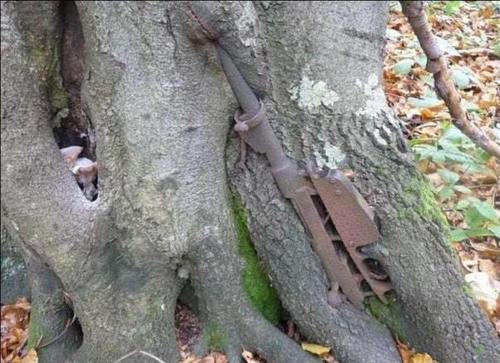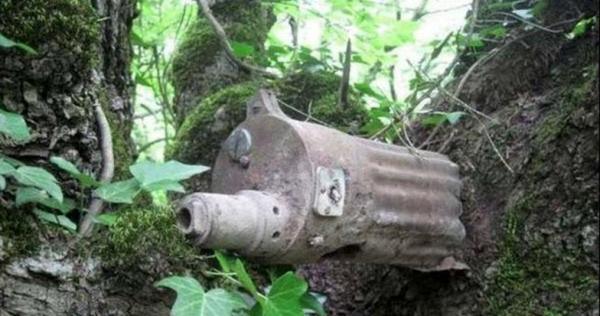These pictures and video were published on War History Online in two separate articles over the course of the past six months. The images and video are absolutely astounding. It seems that a duo of treasure hunters or artifact seekers, using commercial metal detectors have an excellent grasp of the battles on the World War Two Eastern front, and use that knowledge to discover all kinds of stuff still laying around. Some of it is still visible at ground level, while most of it is just barely covered with soil. You see one of them scrapping out an STG44, barely a couple inches below the surface, and in another clip a PPSH41 and an MG34 spare barrel. They certainly have the history knowledge down, but I hope they know a thing or two about high explosives, as they very foolishly/bravely are yanking out mortar ends and other ordnance out of the ground.
French and Belgian farmers have a term for this whole thing, the “Iron Harvest” where over 90 tons of metal/guns/ ordnance is pulled out of the fields through plowing. To this day in Europe, there is still unexploded ordnance killing civilians, long after the World Wars they were expended in. On a side note, for any Band of Brothers/101st aficionados out there, there is a passage in the book where Ambrose is with one of the Easy company vets on a trip back to their old battle sites of World War Two. This particular visit was in Belgium and one of the vets was talking about how they were set up in the field they were standing in, saying something like, ‘the Germans were over there, and we were along this way, and I set up my machine gun team at that corner right there’, while pointing to a spot where one of the vets grandchildren was standing. The grandchild looked down, bent over, and picked up a spent .30-06 casing that would have been fired out of the 1919A6 light machine gun the vet was talking about.
I’m not sure what the laws in Russia are when it comes to searching for, digging up, and keeping relics on former battlefields, but I know the United States has various laws about it depending on the site and equipment used. Some you can dig up and keep to your hearts content, others you can only search, but the owner/government has the first right to keep it, and others everything is strictly forbidden. From the relic hunters-
WWII Relic Hunting/Metal Detecting Episode V: This is a video of our February tour .We spent two days on the former Eastern Front, visiting multiple locations. Though it was a really short trip, we found some very good relics. We found a Sturmgewehr 44 or StG44, the Soviet PPSh-41, a German Karabiner 98 or Kar98/K98 and a total of 3 helmets, the M42 (2x) and the M40. We also found lots of smaller finds, like a tank track, a Wehrmacht belt buckle, war time coins, canteens, mess tins, casings etc.
And a very stern warning towards those wishing to profit off of their finds. They seem to be good stewards of history-
Dear viewers, recently we received several offers from different people to buy the video material we shot on our trips, as well as information about our finds and locations, to be used in films or documentaries (mostly about the international market in military objects). We’ve even been asked to take a film crew with us on one of the trips.
We have declined all these offers, because a) we don’t do this for money and b) since we have never sold a thing we have found (and never will) we do not want to help making a video about the relic market. If there’s one stereotype we don’t want to support, it’s that of the the amateur digger who sells his finds to the highest bidder.

The region of Russia this was found in is called Nevsky Pyatachok, a site of a fierce battle where the Soviet Union fought to try and relieve the siege of Lenningrad. The BBC has an excellent article on some of the body recover efforts doing on there. You might be thinking, what is a Carcano doing in Russia, where most of the fighting was done with Mausers and Mosin Nagants? Well, the Italian army initially had more than 200,000 men deployed alongside German units, fighting the Soviets.
 Your Privacy Choices
Your Privacy Choices
